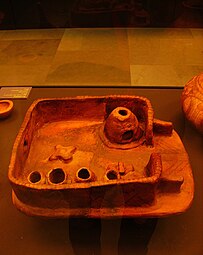Neolithic architecture
This article needs additional citations for verification. (January 2013) |

Neolithic architecture refers to structures encompassing housing and shelter from approximately 10,000 to 2,000 BC, the
Architectural advances are an important part of the Neolithic period (10,000-2000 BC), during which some of the major innovations of human history occurred. The domestication of plants and animals, for example, led to both new economics and a new relationship between people and the world, an increase in community size and permanence, a massive development of material culture, and new social and ritual solutions to enable people to live together in these communities. New styles of individual structures and their combination into settlements provided the buildings required for the new lifestyle and economy, and were also an essential element of change.[1]
Housing
-
The interior of a reconstructed Çatalhöyük house
-
Pottery miniature of aCucuteni-Trypillianhouse
-
Miniature of a regular Cucuteni-Trypillian house, full of ceramic vessels
-
Reconstruction of a settlement of the Linear Pottery culture, 5th millennium BC, in the Archaeological Museum of Kelheim (Lower Bavaria, Germany)
The Neolithic people in the
In Europe, the Neolithic long house with a timber frame, pitched, thatched roof, and walls finished in wattle and daub could be very large, presumably housing a whole extended family. Villages might comprise only a few such houses.
Neolithic
In Romania, Moldova, and Ukraine, Neolithic settlements included wattle-and-daub structures with thatched roofs and floors made of logs covered in clay.[2] This is also when the burdei pit-house (below-ground) style of house construction was developed, which was still used by Romanians and Ukrainians until the 20th century.[citation needed]
Neolithic
- Göbekli Tepe in Turkey, ca. 9,000 BC
- Epipaleolithic Natufian culture
- Nevali Coriin Turkey, ca. 8,000 BC
- Çatalhöyük in Turkey, 7,500 BC
- Mehrgarh in Pakistan, 7,000 BC
- Orkney Islands, Scotland, from 3,500 BC
- over 3,000 settlements of the from 5,400 to 2,800 BC.
Tombs and ritual monuments
-
Dolmen de Coste-Rouge in Soumont (France)
-
Megalithic tomb in Mane Braz (Brittany)
Elaborate
monuments.Megalithic architecture
Megaliths found in Europe and the Mediterranean were also erected in the Neolithic period. These monuments include megalithic tombs, temples and several structures of unknown function. Tomb architecture is normally easily distinguished by the presence of human remains that had originally been buried, often with recognizable intent. Other structures may have had a mixed use, now often characterised as religious, ritual, astronomical or political. The modern distinction between various architectural functions with which we are familiar today, now makes it difficult for us to think of some megalithic structures as multi-purpose socio-cultural centre points. Such structures would have served a mixture of socio-economic, ideological, political functions and indeed aesthetic ideals.
The megalithic structures of Ġgantija, Tarxien, Ħaġar Qim, Mnajdra, Ta' Ħaġrat, Skorba and smaller satellite buildings on Malta and Gozo, first appearing in their current form around 3600 BC, represent one of the earliest examples of a fully developed architectural statement in which aesthetics, location, design and engineering fused into free-standing monuments. Stonehenge, the other well-known building from the Neolithic would later, 2600 and 2400 BC for the sarsen stones, and perhaps 3000 BC for the blue stones, be transformed into the form that we know so well. At its height Neolithic architecture marked geographic space; their durable monumentality embodied a past, perhaps made up of memories and remembrance.
In the Central Mediterranean, Malta also became home of a subterranean
Other structures
Early Neolithic water wells from the
The world's oldest known engineered roadway, the Sweet Track in England, also dates from this time.[citation needed][4]
See also
- Ancestral Puebloans
- Architectural history
- Megalithic Temples of Malta
- Ħal-Saflieni Hypogeum
- Womb tomb
- Proto-city
References
- ISBN 978-0-500-29148-1.)
{{cite book}}: CS1 maint: multiple names: authors list (link - ^ Gheorghiu, D. (2010). The technology of building in Chalcolithic southeastern Europe, pp. 95–100. In Gheorghiu, D. (ed.), Neolithic and Chalcolithic Architecture in Eurasia: Building Techniques and Spatial Organisation. Proceedings of the XV UISPP World Congress (Lisbon, 4–9 September 2006) / Actes du XV Congrès Mondial (Lisbonne, 4–9 Septembre 2006), Vol 48, Session C35, BAR International Series 2097, Archaeopress, Oxford.
- ^ Early Neolithic Water Wells Reveal the World's Oldest Wood Architecture Tegel W, Elburg R, Hakelberg D, Stäuble H, Büntgen U (2012) Early Neolithic Water Wells Reveal the World's Oldest Wood Architecture. PLoS ONE 7(12): e51374. doi:10.1371/journal.pone.0051374
- ^ "The Sweet Track". World History Encyclopedia. Retrieved 2019-02-24.







